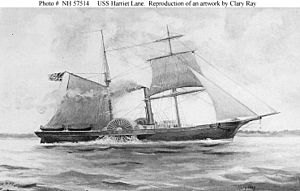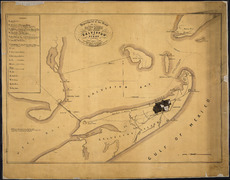Battle of Galveston Harbor (1862) facts for kids
Quick facts for kids Battle of Galveston Harbor |
|||||||
|---|---|---|---|---|---|---|---|
| Part of the Trans-Mississippi Theater of the American Civil War |
|||||||
 USRC Harriet Lane |
|||||||
|
|||||||
| Belligerents | |||||||
| Commanders and leaders | |||||||
| William B. Renshaw | Joseph J. Cook | ||||||
| Units involved | |||||||
| Western Gulf Blockading Squadron | Galveston garrison | ||||||
| Strength | |||||||
| Five naval vessels | Artillery regiment | ||||||
| Casualties and losses | |||||||
| None | None | ||||||
The Battle of Galveston Harbor happened on October 4, 1862, in Galveston, Texas. This event was part of the American Civil War. The Union Navy wanted to take control of Galveston's important port.
Before the battle, the Union had tried to stop ships from entering or leaving Texas ports. But these efforts were not working well. Galveston was defended by Confederate soldiers, but many of their cannons had been moved away. The Confederates thought Galveston couldn't be defended easily.
On October 4, five Union ships, led by Commander William B. Renshaw, sailed towards Galveston. One ship, the USRC Harriet Lane, went into Galveston Bay with a flag of truce. This meant they wanted to talk, not fight.
The Confederate commander, Colonel Joseph J. Cook, had trouble getting a boat to Harriet Lane in time. The Union ship left the bay. Then, the Confederate boat headed for the Union fleet. Both sides were flying flags of truce. But misunderstandings led to some shots being fired.
Eventually, a four-day truce was agreed upon. The terms of this truce were not very clear. The Confederates used this time to leave the city. Commander Renshaw first objected, but then accepted it. When the truce ended, Union troops landed in Galveston. They raised the United States flag over the city.
However, the Confederates took Galveston back on January 1, 1863. This happened during the Battle of Galveston. Today, the area where the battle took place has changed a lot. New buildings and changes to the shoreline mean it doesn't look like it did during the war.
Contents
Why Galveston Was Important
When the American Civil War started in April 1861, President Abraham Lincoln announced a naval blockade. This meant Union ships would try to stop all trade to and from Confederate ports. The goal was to cut off the Confederate States of America from foreign goods and support.
Galveston was the most important port in Texas for the Confederates. Union Navy ships were sent to the Texas coast to enforce the blockade. But at first, it wasn't very effective. International law at the time said a blockade had to be "effective" to be legal. In December, a British ship visited Galveston and saw no Union Navy ships. This showed the blockade wasn't working well yet.
Because of the shape of Galveston Bay, blocking the port needed at least two ships.
Confederate Defenses
Confederate forces, led by Major General John B. Magruder, tried to defend Galveston. They set up artillery batteries, dug trenches, and blocked parts of the harbor. But these defenses were not very strong. One Confederate officer even wrote that the city could not be defended.
The Union blockade was still struggling. So, the Union decided to capture some Confederate ports. This would give Union ships more places to stop. It would also make it harder for ships called blockade runners to bring supplies to the Confederates.
In May 1862, a Union ship demanded Galveston surrender. They threatened to attack, but it didn't happen. In August, Union Admiral David Farragut ordered Commander William B. Renshaw to destroy blockade runners. He also told Renshaw to capture Galveston if he could.
Galveston Island itself was defended by only one artillery regiment. This group was led by Colonel Joseph J. Cook. The island was connected to the mainland by a bridge. Union spies thought the mainland end of the bridge was strongly defended, but it wasn't. Confederate defenses at Fort Point, which guarded the bay's northern entrance, were also weak. The Confederates had almost no naval ships nearby.
Other Confederate troops were in the Houston area. There were also soldiers along the railway between Houston and Galveston. This brought the total number of Confederate troops in the region to about 5,000. Many of the cannons in Galveston's defenses had been removed. Confederate Brigadier General Paul Octave Hébert believed the city could not be defended.
The Battle Begins
Renshaw moved towards Galveston with five Union ships. They reached the city by early October. The five Union ships were the USS Westfield (Renshaw's main ship), USRC Harriet Lane, USS Owasco, USS Clifton, and the mortar schooner USS Henry Janes.
Westfield, Clifton, and Harriet Lane were sidewheel steamers. Owasco was a screw steamer gunboat. Harriet Lane went into Galveston Bay early on October 4. It was flying a flag of truce.
The Union officers waited for Confederate messengers to come to the ship. When no one arrived, a boat from Harriet Lane went ashore. They met with Colonel Cook. Cook agreed to send a group to the Union fleet to talk about surrendering.
Cook's men had trouble finding a boat. They were delayed until 1:00 PM. By then, Lieutenant Commander Jonathan Mayhew Wainwright, who commanded Harriet Lane, had grown impatient. He left Galveston Bay.
Misunderstandings and Truce
The Confederate boat was seen by Renshaw's fleet outside the bay. The Union ships then started moving into the bay. They were clearly flying flags of truce.
Suddenly, a Confederate cannon at Fort Point fired a warning shot. It went across the front of one of the Union ships. The Union fleet thought this was a hostile act. Union ships quickly fired back. They knocked out the single Confederate cannon at Fort Point. Confederate artillery in Galveston also fired at the Union ships. But they were too far away to hit anything.
The Union ships were still flying truce flags while firing. Renshaw realized that continuing to fire would be against the rules of war. So, he ordered his ships to stop firing. Both Renshaw and Cook believed the other side's shots were on purpose.
Cook's messengers finally reached Westfield. Renshaw demanded that Galveston surrender immediately. He threatened another attack if they didn't agree. The Confederates refused. They reminded Renshaw that he would be responsible for any damage to private property or civilian deaths if he attacked.
The two sides then made a verbal agreement for a four-day truce. The terms were that Union ships would not get closer to Galveston. Also, the Confederates would not build new defenses or work on existing ones.
However, each side understood the truce differently. Renshaw thought it meant everything would stay the same militarily. Cook thought he could use the time to evacuate Galveston. As a result, the Confederates used the truce to move supplies and cannons out of the city.
Renshaw thought the Confederates were breaking the truce on purpose. But after talking to Cook, he accepted their explanation. The removed items were not very valuable. Renshaw also believed he couldn't stop the Confederates from moving the cannons anyway.
Galveston Falls to the Union
After the truce ended, Renshaw ordered three signal shots to be fired. The mayor and city council of Galveston then went to Westfield and surrendered the city.
A group of 150 Union men, led by the commander of Harriet Lane, landed. They raised the United States flag over the city. There were no Confederate defenders left in Galveston. The only cannon the Confederates had left behind was the one disabled during the October 4 firing. They also left several fake cannons, known as Quaker guns, in the empty defenses.
The National Park Service says there were no casualties during this action. However, another historical guide says the number of casualties is unknown.
What Happened Next
Soon after Galveston fell, the Union Navy gained control of the waters near Corpus Christi and Sabine City. This gave the Union control over most of the Texas coastline.
However, there were problems getting Union infantry (foot soldiers) to hold Galveston. Two small incidents in November led to the capture of small groups of Union soldiers. Finally, on December 25, an infantry group of 264 men arrived.
But on January 1, 1863, a Confederate force attacked Galveston. They defeated the Union forces defending it in the Battle of Galveston. Renshaw was killed when he tried to sink his own ship, Westfield, to keep it from being captured. Harriet Lane was captured by the Confederates. The Confederates took back control of Galveston.
A study in 2010 noted that the area where the battle happened has changed a lot. New buildings and changes to the shoreline mean it doesn't look like it did during the war.
Images for kids




